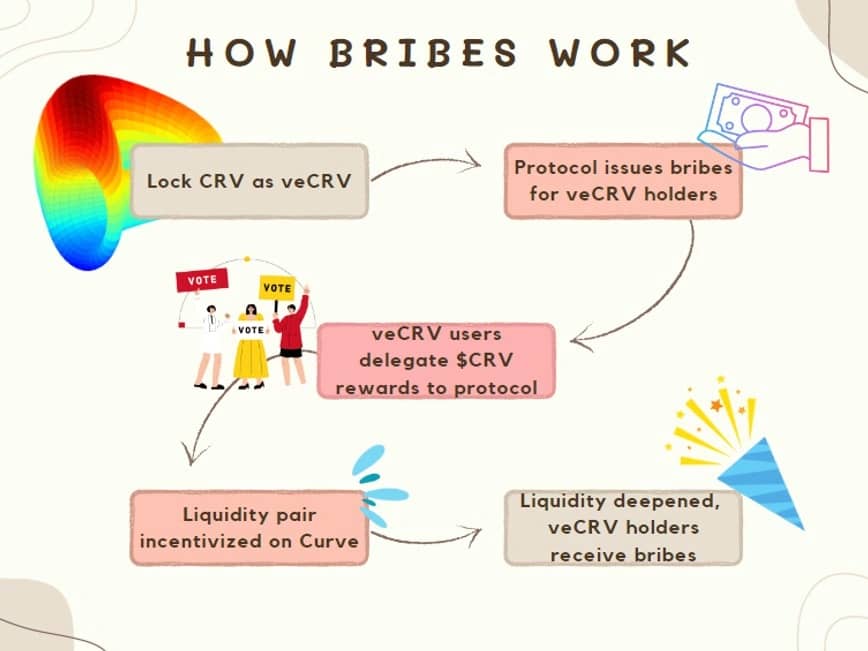Subscribe to wiki
Share wiki
Bookmark
Bribes
We've just announced IQ AI.
Bribes
Bribes are incentive rewards given by protocols to increase liquidity for their token. The main objective of bribes is to attract more users to a specific liquidity pool. [1]
Overview
The term "bribes" in the context of DeFi was indeed popularized by users of Curve Finance. Bribes are given to governance token holders of the DeFi platform where protocols have their tokens in a liquidity pool. These token holders have the power to vote for their liquidity pool, and more votes mean more emissions earned by the pool, resulting in higher rewards. [1]
Governance token holders, such as those holding Curve's CRV tokens, have the power to vote on which liquidity pools receive more emissions. More votes for a pool result in higher emissions and, consequently, higher rewards for those providing liquidity to that pool. Protocols seeking to boost the liquidity of their pools offer bribes to these voters to secure more emissions. By offering these bribes, protocols can effectively ensure that their liquidity pools attract more liquidity, as the increased emissions lead to higher Annual Percentage Rates (APRs), which are attractive to liquidity providers.[3]
Essentially gauges allow some users to incentivize other users for a certain behavior during a certain period of time by giving bribe to whoever commits to that behavior in that period. As an example, Thena is a popular DEX on the BNB chain that is using the concept of gauges to attract more liquidity to its pools. Frax finance is a major DEFI protocol on Thena who owns most prominent FXS, FRAX and frxETH pools. At each period (each week), Thena, like Sushiswap, offers new emission of its coin to liquidity providers (LP’s) on each pool relative to how important the pool is. The importance of each pool is decided through community voting in the preceding period. Frax finance influences this community decision by assigning bribes(in the form of FXS token) to whoever votes for the importance of its pools. Thereby hoping to attract more LP’s to its pools.[8]
DeFi Bribes Examples
MIM - Abracadabra
During the bull market, one notable user of bribes was $MIM, the native stablecoin of Abracadabra, a money-market protocol created by Daniele Sesta. The primary goal of $MIM was to become the leading cross-chain stablecoin, requiring deep liquidity pairs and extensive usage. To achieve this, Abracadabra heavily incentivized $veCRV holders to vote for liquidity pools (LPs) that utilized $MIM. This strategy had two significant effects:
- Increased Liquidity: Trades involving $MIM became extremely liquid, which was crucial during periods of high on-chain activity. This high liquidity ensured that traders did not suffer from slippage and helped $MIM maintain its peg.
- Profitable LP-ing: Providing liquidity for $MIM pairs became highly profitable and virtually risk-free, offering not only trade fees but also substantial rewards from directed emissions.[2]
veWOM - Wombat Exchange

Wombat Exchange utilizes a Voting Gauge system that allows protocols to list tokens on the platform to enhance their liquidity. These protocols provide incentives to encourage users to vote for their pools. Only $veWOM users can vote, and increased votes for a pool lead to higher WOM emissions, which in turn boosts the pool's APR and overall liquidity. Through the voting gauge mechanism, stablecoin and liquid staking protocols can bribe veWOM holders to vote for their pools or build positions in yield-boosting protocols to influence Wombat’s gauges.[4]
In December 2023, Wombat Exchange and Frax Finance joined forces to increase the use of FRAX on the BNB Chain aiming to increase FRAX stablecoin adoption and liquidity on BNB Chain while giving Wombat users more yield opportunities and options. Following the collaboration, FRAX was included in Wombat’s Innovation Pool, where WOM emissions would be given as a liquidity incentive to support the pool. Once the voting gauge is active, users may receive bribes by casting their votes for the FRAX gauge. [5]
Fraxtal Incentive Program
On March 11, 2024, Fraxtal the Layer 2 built by Frax Finance launched their mainnet bridge to the public, marking a significant step in Fraxtals’s transition to becoming a Superchain. Fraxtal is a Modular Rollup that was launched on Feb 7, 2024.
Fraxtal has set up a couple of unique incentive programs. Fraxtal Blockspace and faxtal Point System.
-
The Fraxtal Blockspace Incentives system(Flox): Frox is the primary automated, recurring method that rewards both users and smart contract developers on Fraxtal. Every epoch (initially 7 days), EOA addresses that have spent gas on Fraxtal and the smart contracts that used gas are rewarded. FXTL points proportional to the “Flox Algorithm.”
-
The Fraxtal Point System(FXTL): Fraxtal has also introduced its own points system which is a unique ticker representing points within the Fraxtal ecosystem. It rewards and incentivises participants in the ecosystem including creating and interacting with smart contracts, utilizing new protocols deployed to the chain, and holding specific types of tokens. FXTL points will be tokenized no later than 12 months after the Fraxtal chain genesis. Whether FXTL points will be tokenized as a separate staking token for the chain or converted to FXS tokens at a specified ratio will be revealed in the future. [6][7]
See something wrong?
